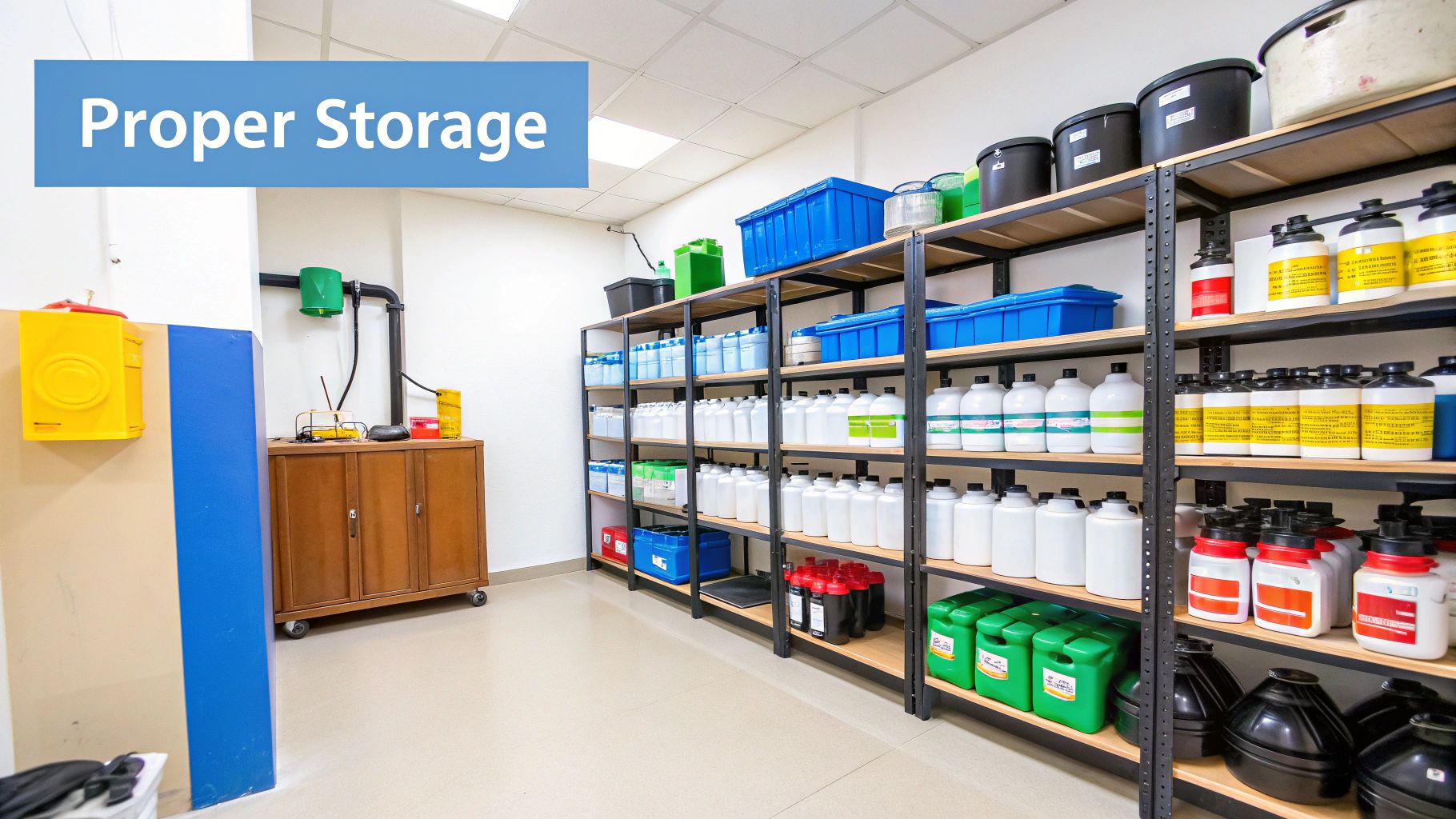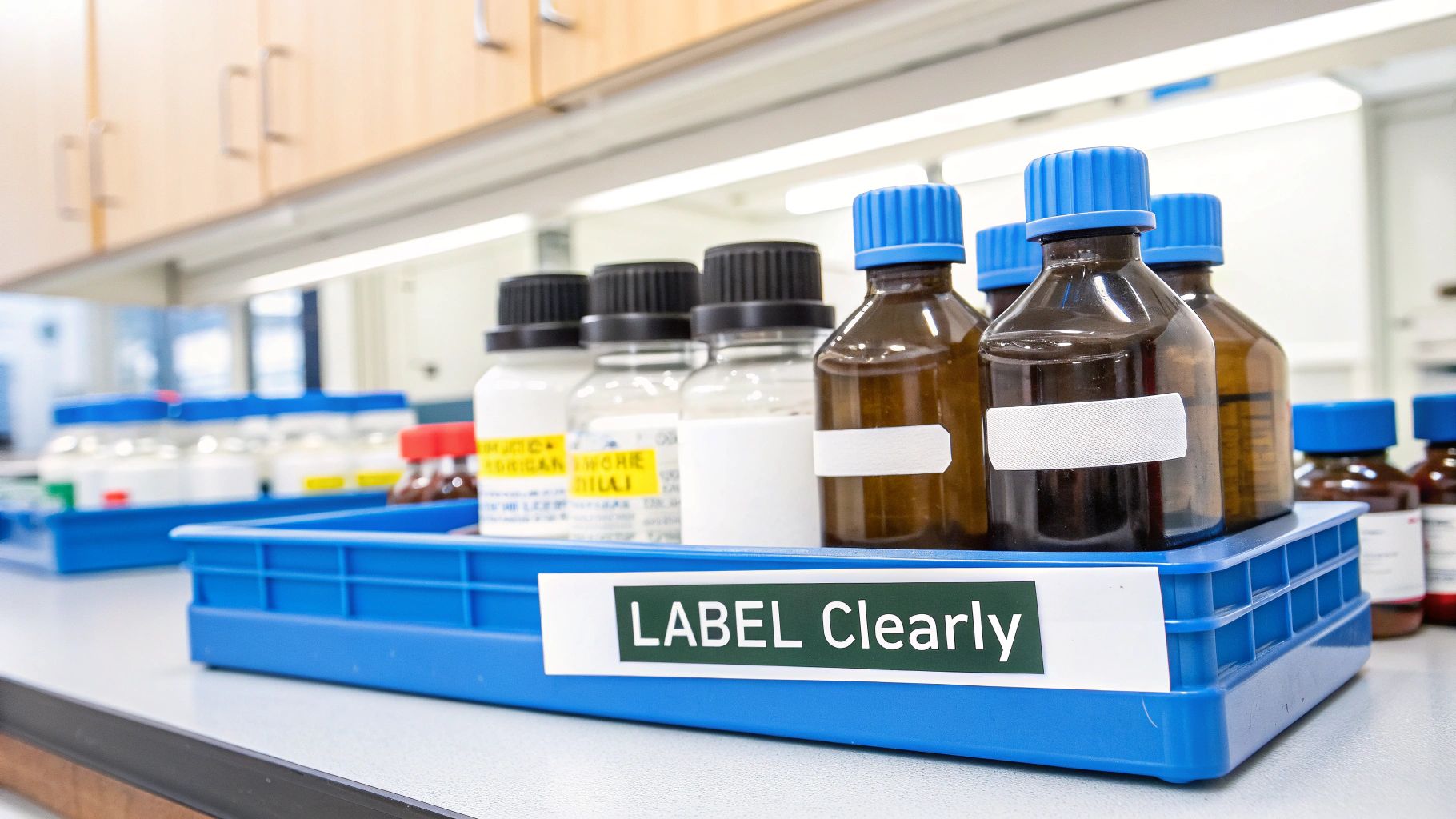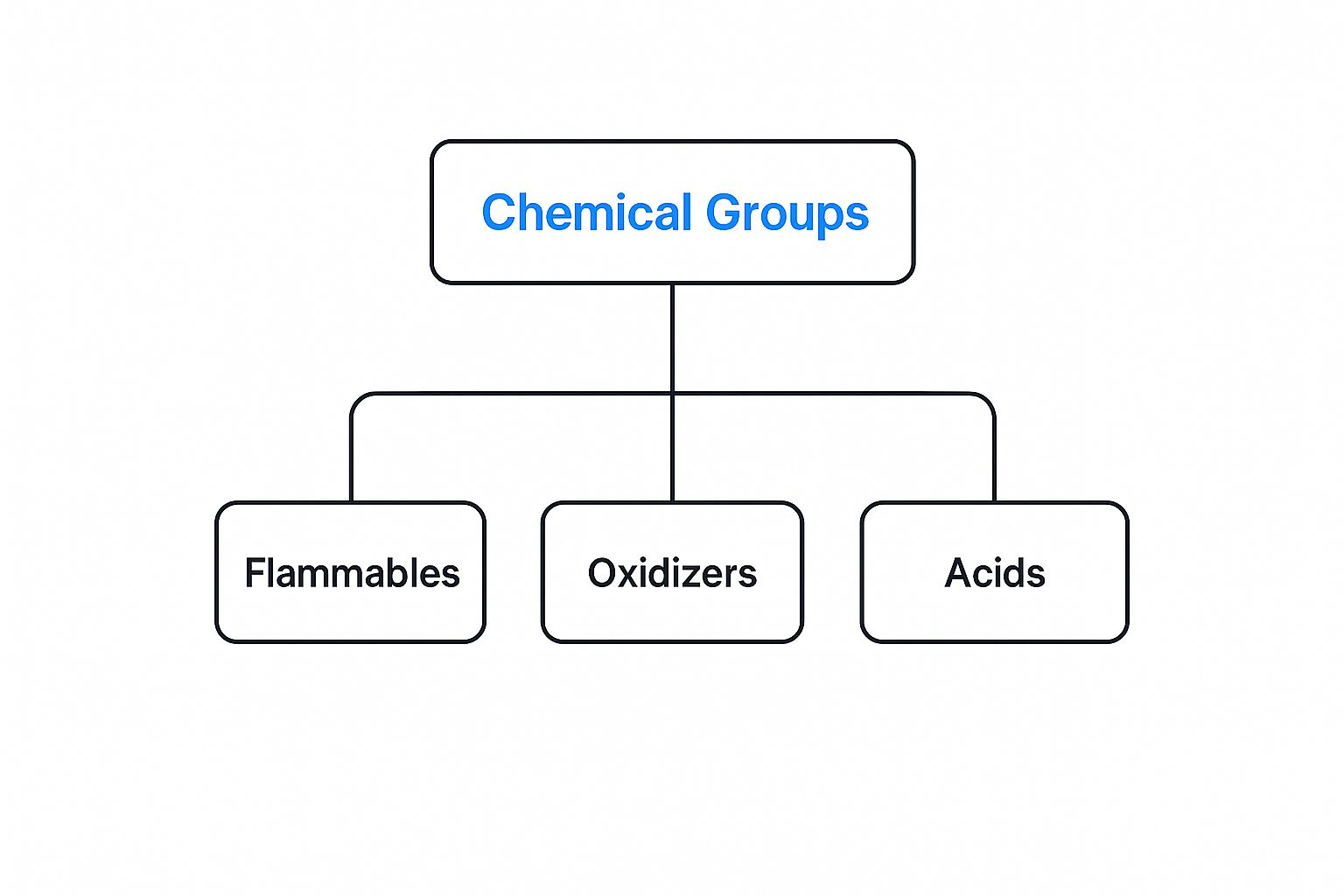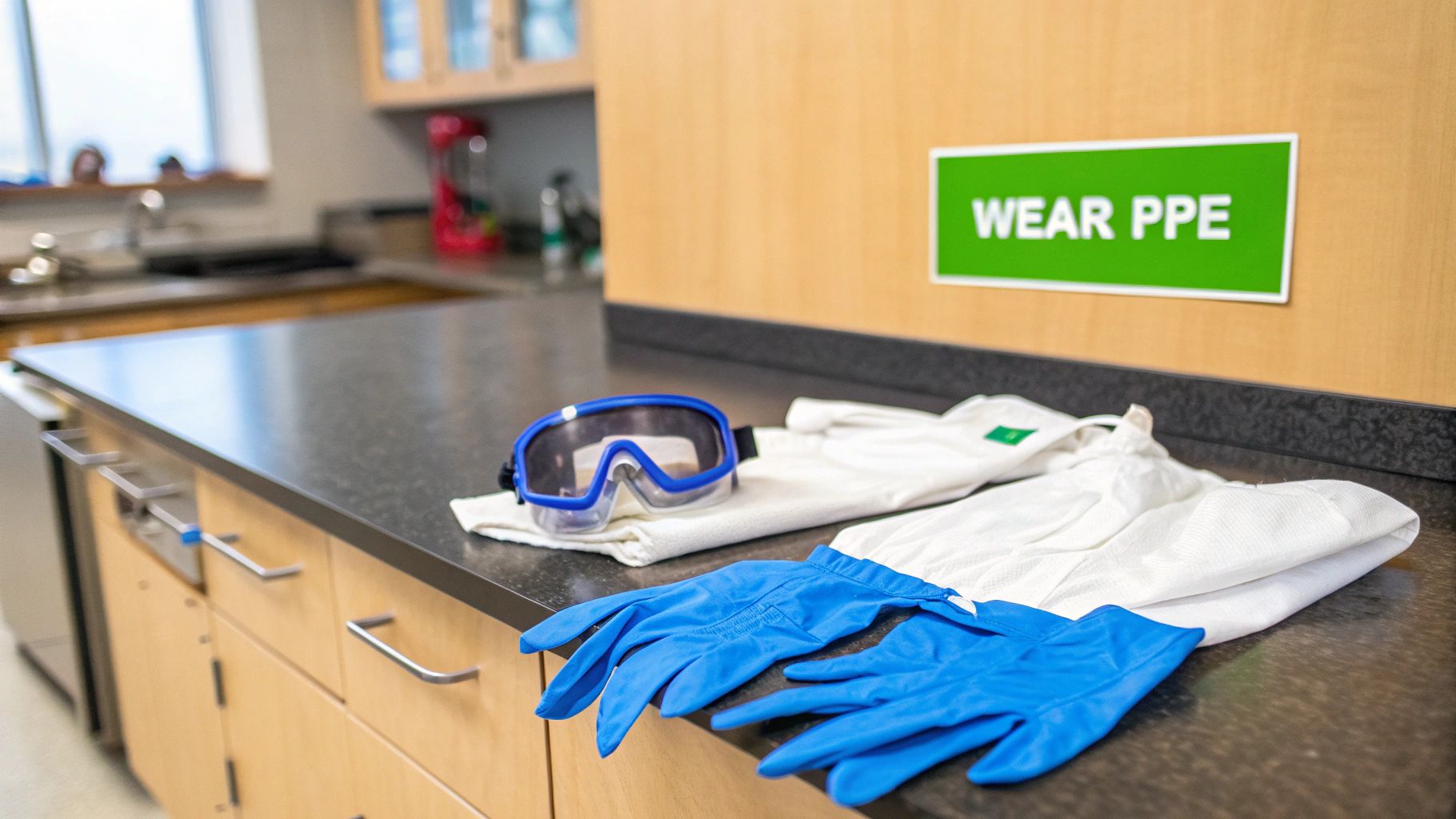Chemical storage guidelines are the bedrock of safety in any facility that handles hazardous materials. They provide the essential rules for handling, separating, and containing chemicals to prevent accidents, injuries, and serious environmental harm. Think of them as the operating manual that turns a potentially chaotic and dangerous space into a controlled, safe, and compliant one through systematic organization and risk management.
Failing to follow proper chemical storage guidelines isn't a minor slip-up; it's a direct invitation to disaster. Whether you're in a small workshop or a massive warehouse, hazardous materials bring significant risks. Without a structured approach, you're not just risking non-compliance and steep fines. You're risking catastrophic events like fires, explosions, or toxic gas releases that can injure your team, destroy your assets, and cause lasting environmental damage.
Imagine a pharmacy. Medications aren't just thrown onto shelves alphabetically. A pharmacist meticulously organizes them by type, strength, and potential interactions. You'd never find powerful prescription drugs mixed in with over-the-counter vitamins. This exact logic is the cornerstone of safe chemical management. When you organize substances by their hazard class—not just their name—you prevent dangerous reactions from ever having a chance to occur.
The real purpose of chemical storage guidelines is proactive risk management. It’s about building a system where safety isn’t an afterthought but is woven into every single step of handling and storing materials, much like a blueprint for a sturdy building.
A truly robust safety strategy is built on several interconnected principles. It's a mistake to view them as a simple checklist; they work in tandem to create multiple layers of defense against accidents. If one part of the system fails, the others are there to back it up. For example, even a perfect segregation plan is useless if your ventilation is poor, as hazardous fumes could accumulate and mix in the air.
Here are the key principles that work together:
Putting these principles into practice is fundamental, especially when you're dealing with specialized logistics. Gaining a full understanding of hazmat warehouse requirements will give you a deeper insight into creating a facility that is not only safe but also fully compliant with all the complex regulations.
Before you can even think about where to store a chemical, you need to know exactly what you're dealing with. Getting your chemical storage right starts with being able to quickly and accurately read the hazard information on every container.
Think of chemical labels and their matching Safety Data Sheets (SDS) as the instruction manuals for keeping everyone safe. Once you know how to read them, a potentially dangerous container becomes a known quantity, with clear, non-negotiable rules for handling and storage.

This is all made possible by a universal standard called the Globally Harmonized System (GHS) of Classification and Labelling of Chemicals. The GHS was created to standardize how chemical hazards are classified and communicated across the globe. This means a warehouse operator in Houston and a lab tech in Hamburg can look at the same label and immediately understand the risks.
The GHS label is designed for quick, at-a-glance risk assessment. It uses several key elements that, together, paint a very clear picture of a chemical's potential dangers.
Understanding a GHS label is a fundamental skill. This isn't just about checking a compliance box; it's about getting immediate, life-saving information. The most obvious features are the pictograms—simple, visual warnings that tell you the type of hazard you're facing in an instant.
These diamond-shaped symbols communicate specific risks:
Beyond the pictograms, you’ll find a signal word. "Danger" is used for the most severe hazards, while "Warning" indicates less severe, but still significant, risks. This is followed by hazard statements, which are standardized phrases that get straight to the point (e.g., "Causes severe skin burns and eye damage"). Finally, precautionary statements give you actionable advice on what to do to handle the chemical safely.
While the GHS label is the snapshot, the Safety Data Sheet (SDS) is the complete encyclopedia. It's a mandatory 16-section document that provides every last detail you need for safe handling, storage, and emergency response. You don't need to memorize all 16 sections, but knowing exactly where to look for critical information is non-negotiable.
Think of the GHS label as the headline and the SDS as the full story. You need both to create a safe work environment, and they form the bedrock of any effective chemical storage plan.
For your day-to-day storage decisions, you'll find yourself turning to a few key sections over and over again:
For example, when you're setting up your storage area, a quick look at Section 7 will tell you things like "Store in a well-ventilated place" or "Keep away from heat." Then, a cross-reference to Section 10 will explicitly warn you not to store that substance next to acids or oxidizers.
This level of detail extends beyond just handling the chemical itself. Global regulations are increasingly focused on the entire lifecycle of the packaging. For instance, new EU rules will require packaging to incorporate up to 65% recycled content by 2040 and are restricting harmful substances like PFAS. This means your storage guidelines must also account for the safety and compliance of the packaging, all the way to its disposal. It's a good idea to dive deeper into these evolving global regulations to understand how they will impact your chemical management practices.
Alright, let's get practical. Moving from theory to the real world, designing a safe and compliant chemical storage area is one of the most critical steps you can take. Think of it like setting up a professional kitchen. Everything has a specific place, not just for convenience, but for safety and efficiency—hot zones are kept separate from cold storage, and prep areas are always clear. The same logic applies to your chemical storage.

Your first major decision is the physical location. The storage area has to be positioned away from high-traffic work zones to cut down on the risk of accidental contact. Even more importantly, it must be completely isolated from any operational processes that involve open flames, sparks, or intense heat. No exceptions.
This investment in proper infrastructure is backed by major industry trends. The chemical storage tank market, valued at roughly $4.5 billion in 2023, is on track to hit $6.9 billion by 2032. This growth isn't just about needing more tanks; it’s driven by the demand for advanced solutions that meet tough regulatory standards for safety and containment.
A dedicated chemical storage area is far more than just a room with shelves; it's a carefully engineered environment. Each component works in concert to build a multi-layered safety system that protects your people, your facility, and the environment.
The table below outlines the non-negotiable features you'll need to build a compliant and safe storage space.
Getting these core elements right from the start is fundamental to meeting chemical storage guidelines and, more importantly, ensuring a safe workplace.
Once the core infrastructure is in place, your focus shifts to the operational details that ensure day-to-day safety. This is all about controlling who can access the area and making sure everyone has the resources they need in an emergency.
Securing the area is simple: it keeps unauthorized personnel out, which dramatically reduces the risk of accidental exposure or mishandling. It's also smart to think about how broader industrial security solutions can protect your valuable inventory from tampering or theft.
An effective storage design strikes a crucial balance between security and accessibility. The area must be locked down to prevent unauthorized entry but remain easily reachable for trained personnel and emergency responders.
This principle is especially important in large-scale operations. For example, solid layout and security protocols are vital when figuring out what a fulfillment center is and how it can safely manage regulated goods for e-commerce clients.
Finally, you have to equip the area with immediate-response safety tools and clear, unmistakable communication aids.
Essential Safety and Signage Checklist:
One of the most common—and dangerous—mistakes in any facility is storing incompatible chemicals together. This isn't just a matter of poor organization; it's a recipe for disaster. Proper chemical segregation is all about physically separating substances based on their hazard class, not just their name or how often they're used.
Think of it as a strict "no-contact" list for your inventory.
Ignoring these rules can have catastrophic consequences. Imagine storing a common acid like hydrochloric acid next to a base like sodium hydroxide. Everything seems fine until a small leak occurs, triggering a violent, heat-generating reaction. An even more frequent mishap is the accidental mixing of household bleach (sodium hypochlorite) and ammonia, which instantly creates toxic chloramine gas—a serious respiratory hazard. These aren't just abstract risks; they are real-world emergencies that proper segregation is designed to prevent.
The foundation of safe segregation is knowing which chemical families must never meet. This is where a chemical compatibility chart becomes an essential tool. It acts as a simple, visual guide, showing which hazard classes can be stored near each other and which must be kept far, far apart. Using one of these charts takes the guesswork out of the equation and gives your team clear, actionable instructions.
You don't need to memorize every single chemical interaction. Instead, focus on understanding the most dangerous and common incompatibilities that are present in nearly every industrial setting.
This infographic shows the critical separation required between three common but highly reactive chemical groups.

As the diagram clearly illustrates, Flammables, Oxidizers, and Corrosives (like acids) are fundamentally incompatible. They must always be stored in complete isolation from one another to prevent dangerous reactions.
Putting these principles into practice requires a mix of physical barriers and solid operational procedures. It's about creating a warehouse environment where accidental mixing is almost impossible. A well-organized system also leads to better workflows and, as many guides on inventory management tips and tricks point out, fewer handling errors.
Here are some effective strategies you can implement in your facility:
The ultimate goal of segregation isn't just to follow a rulebook—it's to build an intuitive system. A new employee should be able to understand the "do not mix" zones simply by looking at the layout and signage of your storage area.
Sometimes, segregation needs to be even more specific. For instance, within the corrosives class, strong acids and strong bases should not be stored together. While both are corrosive, their reaction can be violent.
A perfect example of this is nitric acid. It's not only a corrosive acid but also a powerful oxidizer, meaning it must be isolated from nearly everything—including other organic acids like acetic acid.
When in doubt, always refer to the Safety Data Sheet (SDS) for each chemical. Section 10 (Stability and Reactivity) of the SDS is your definitive guide, as it explicitly lists materials to avoid. This document provides the specific details you need to make informed decisions that go beyond general compatibility charts, ensuring your storage practices are as precise and safe as possible. Your commitment to these details is what prevents dangerous reactions before they ever have a chance to start.
Staying Compliant with Chemical Storage Regulations
Following chemical storage guidelines isn't just a good idea—it's the law. Diving into the complex world of regulations from agencies like the Occupational Safety and Health Administration (OSHA) can feel like a mammoth task. But when you break it down, building a solid compliance program is more than achievable. A proactive approach doesn't just sidestep hefty fines; it builds a true, lasting culture of safety.
Think of regulatory compliance as the foundation holding up your entire safety system. Without it, even the most perfectly designed storage area is on shaky ground. The real goal is to create a program that doesn't just scrape by on minimums but goes above and beyond, making your operation resilient to accidents and ready for any regulatory check-in.
An effective compliance strategy really boils down to three core pillars. These elements work together to give you a clear, real-time snapshot of your chemical inventory and its risks, making it much easier to stick to strict chemical storage guidelines.
Here’s where you should focus your energy:
A strong compliance program turns reactive scrambling into proactive management. It transforms regulatory requirements from a burden into a clear roadmap for maintaining a safe, efficient, and legally sound workplace.
Compliance isn't a "set it and forget it" task—it's a continuous commitment. Chemical regulations are always changing, and what happens globally often trickles down to local rules. For instance, major updates in global chemical regulations set for 2025 are already changing storage protocols around the world.
The introduction of Ukraine REACH in January 2025 requires progressive registration of chemicals based on import volume. This change forces businesses to sharpen their inventory tracking and beef up storage for higher-risk substances. Staying on top of these shifts is key to keeping your safety practices current.
Managing hazardous materials also brings logistical headaches, especially in e-commerce fulfillment, where you have to balance speed with safety. If you're in this space, knowing the specific rules is non-negotiable. For a closer look at the requirements for one of the biggest online marketplaces, check out our guide on FBA hazmat guidelines. Keeping yourself informed ensures your operations stay both safe and competitive.
Even when you follow every single chemical storage guideline to the letter, things can still go wrong. It happens. A container gets dropped, a valve fails, or simple human error leads to a dangerous spill or release. This is precisely why having a robust, well-rehearsed emergency response plan isn’t just a good idea—it's an absolute necessity.
Think of it like the smoke alarms and fire extinguishers in your home. You hope you never have to use them, but you’re a whole lot safer just by having them there. An emergency plan does the same thing for your warehouse, transforming potential chaos into a series of clear, decisive actions designed to protect lives, contain the incident, and minimize damage.
A well-developed emergency response plan is your team's muscle memory. When an incident occurs, it ensures that instead of freezing, your staff acts decisively and safely, following steps they have practiced before.
A truly effective plan is so much more than a document sitting in a binder; it's a comprehensive action guide for a crisis. It needs to cover every angle of a potential incident, from the first moment of discovery all the way through the final cleanup. To make sure your plan is up to snuff and meets regulatory standards, it's smart to use resources like an OSHA Emergency Action Plan template. These guides provide a practical framework for handling workplace emergencies.
Your plan must clearly spell out several critical elements:

Here’s the most important part: a plan that only exists on paper is completely useless. You absolutely must train your team to use all the safety equipment, from spill kits to Personal Protective Equipment (PPE), correctly and confidently.
The best way to do this is by conducting regular drills. Walk your team through a realistic spill scenario, like a leaking drum of corrosive acid. This kind of hands-on practice is invaluable. It helps everyone spot weaknesses in the plan—like a spill kit that’s hard to get to or an unclear evacuation route—long before a real emergency strikes.
Ultimately, a well-rehearsed team is your greatest asset for turning a potential disaster into a controlled event.
Even with the best guidelines in place, real-world questions about chemical storage always come up. Getting clear, practical answers is key to building your team's confidence and making sure safety protocols are followed every single time. Here, we tackle some of the most common challenges and points of confusion that facilities run into day after day.
Consistent inspections are the absolute backbone of any proactive safety program. Think of it as a routine health checkup for the most sensitive part of your facility.
For the best results, you'll want to use a two-tiered approach:
This is a really common point of confusion, but the difference is critical for safe storage. It all boils down to one thing: the flash point. That’s the lowest temperature where a liquid gives off enough vapor to catch fire in the air.
Think of a flammable liquid as a dry twig, ready to ignite with the smallest spark. A combustible liquid is more like a damp log—it needs more heat to get going, but it will definitely still burn.
Flammable liquids, like gasoline or acetone, have a flash point below 100°F (37.8°C). This means they can easily ignite at or even below room temperature, so they demand the strictest storage measures, like specialized flammable safety cabinets.
Combustible liquids have a flash point at or above 100°F. This makes them a bit less volatile, but they still pose a serious fire risk and require careful, dedicated handling.
In most situations, yes—and it’s often the best practice. The original container was specifically designed for that chemical, is made of a compatible material, and should already have the correct GHS-compliant label right on it.
The big "but" here is that the container must be in perfect shape. If it gets damaged, starts to leak, or shows any signs of breaking down, you have to transfer the chemical to a proper secondary container. That new container must be made of a compatible material and be correctly labeled with all the required hazard information.
And one critical point: never, ever use food or beverage containers for chemical storage. This is a surprisingly common cause of accidental poisonings and must be avoided at all costs.
Expired and unwanted chemicals must always be treated as hazardous waste. There are no shortcuts here. Just pouring them down the drain or tossing them in the dumpster can cause severe environmental damage, trigger dangerous reactions in your plumbing, and lead to massive regulatory fines.
The proper disposal process isn't optional. You have to follow all local, state, and federal regulations for managing hazardous waste. This usually involves separating the waste chemicals by compatibility, clearly labeling each container as "Hazardous Waste" with its contents identified, and then working with a licensed disposal company for professional pickup and removal.
Managing complex logistics, especially for hazardous materials, requires expertise and precision. Simpl Fulfillment offers specialized fulfillment services, ensuring your products are stored, handled, and shipped safely and in full compliance with regulations. Stop worrying about logistics and focus on growing your brand. Learn how Simpl Fulfillment can handle the complexity for you.